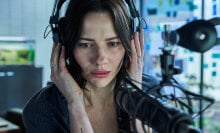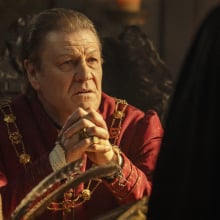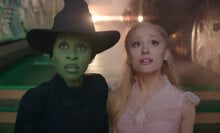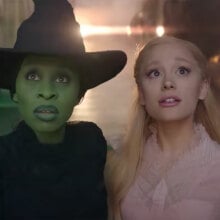The road to the Nimona movie has been long and transformative, reflective of its titular heroine.
Sure, there was the Disney/Fox merger, which cast the in-production Nimona into uncertainty, before Netflix picked it up with support from Annapurna. But before all that, this weird and wonderful tale of misfits and monsters found life and fans online.
Though the new Netflix animated film is based on ND Stevenson's graphic novel, Nimona originally began as a webcomic on the artist's Tumblr account in 2012. There, a growing fandom would swing back regularly for updates, reading new pages from the adventures of a spunky shapeshifter and the supervillain she idolized.
The structure of the webcomic lent itself to cheeky comedic buttons and an occasionally chaotic storytelling structure. So, it's no surprise that Nimona has seen some major changes as it transitioned from Stevenson's passion project to a family-friendly movie with a star-studded cast.
What are these changes? And how have they transformed this shapeshifter's story? Let's dig in, spoilers and all.
1. Ballister Blackheart is now Ballister Boldheart.

The two incarnations of Ballister have a lot in common. Both are dark-haired knights with a robot arm, a broken heart, and an axe to grind against the Institution that caused the latter two. Both are in love with golden boy Ambrosius Goldenloin, the rival knight who cut off that arm. (Which "is not a love language!") But in the graphic novel, Ballister's surname was Blackheart, whereas in the movie, it's Boldheart.
This might seem a superficial change, but it actually reflects a pretty major shift in the character. Beyond his formative mutilation at the hands of his lover, Ballister's backstory was vague in the comic. One Christmas special comic included a look into his youth with a smaller, naive Ambrosius, where Ballister re-gifted his toys to make the blonde boy's holiday hopes come true. But the name "Blackheart" painted him as a villain from the jump, though readers soon learned he was more a revolutionary than the terrorist the Institution propaganda declared. (In the book, he repeatedly had to beg Nimona not to carelessly murder people. In the movie, she's far less homicidal.)
Meanwhile, in the movie, Ballister (voiced by Riz Ahmed) is pronounced as the first commoner who might raise to the respected rank of knight. "Boldheart" is what the queen (voiced by Lorraine Toussaint) dubs him as she begins the knighting ceremony. It's a name reflective of his passion for justice, his big dreams, and his unique achievement despite his humble beginnings. But then, the ceremony goes fatally awry.
2. Ballister loses his arm, the same but different.

In the movie, his arm is severed during the knighting ceremony. Bowed before the queen, he readies for her blessing. Then, his sword — which shoots lasers, because Nimona is set in a world where medieval fantasy and sci-fi tech collide — goes off and kills her. In a hasty and futile attempt to save the queen, Ambrosius (voiced by Eugene Lee Yang) tries to disarm the threat and dis-arms Ballister. Both know it was his training and not a choice, but that doesn't make it sting any less. Just like that, Ballister goes from the kingdom's great new hope to a notorious queen-killer, on the run and desperate to clear his name.
In the graphic novel, Ambrosius is more conceited and selfish, and far less likable. Facing off in a joust against Ballister, he takes a cheap shot, blasting his rival with a lance canon. Was it an accident? Was it on purpose? Ambrosius waffles there. But in both versions of Nimona, the underlying impetus behind Ballister's mutilation and ostracization is the sinister Director of the Institution (voiced by Frances Conroy), who sabotages him so he won't rise to power. In the comic, this seems based more on optics, as Goldenloin looks and sounds more like the ideal knight — even if he's less noble. In the movie, her motivation is explicitly about suppressing the commoner class in favor of the aristocrats.
3. Goldenloin gets a new backstory and a more explicitly queer love story.

Nimona the movie has a great emphasis on class conflict, positioning Ballister and Ambrosius on opposite sides of that divide. To do so, Nimona's makers changed Ambrosius's backstory. In the aforementioned Christmas special, he's presented as a poor kid, scrawny and bullied by the other would-be knights in training. (The toxically bro-y knight Todd from the film might be born from these boys, as he is not explicitly in the comic.)
In the movie, Ambrosius is a descendant of Gloreth, a legendary female knight whose monument holds a sword to defend against the presumably monstrous forces outside the kingdom's high, stone walls. She's such an icon of the kingdom that its residents swear by her and determine their politics based on what they assume she might think, as some Americans do our founding fathers.
While this change to Goldenloin's lineage makes for greater dramatic tension between the two knights, the movie also makes more concrete the love story that was implied for much of the comic. When the two are introduced in the movie — which begins before the graphic novel's story does — they are clearly boyfriends, speaking openly about their relationship and love. And they even share a kiss.
In contrast, the comic, which was aimed at older audiences than the PG movie is, begins with Ballister already wounded, both physically and psychologically. While there are flashbacks to their time before, they're focused on the disarming event. In the present, the pair speak with yearning, but it's mixed with a lot of anger and resentment that prevents the ardent affection or expression seen in the movie adaptation.
4. Nimona's backstory gets a makeover.

In both versions, Nimona (voiced by Chloë Grace Moretz) gives Ballister a fictional account of her origin. In the movie, Nimona says it's a wishing well that gave her these incredible powers to shift her form as she pleases.
In the graphic novel, she claims she was once a little girl who wished she could battle back the raiders who terrorized her village. Then, one day she met a witch who'd fallen down a well; the witch turned her into a dragon so Nimona might aid her in escape. When Nimona returned to the village as a dragon, the villagers chased her off. By the time she figured out how to turn back into a girl, the village had been destroyed by raiders. In both versions, Ballister is a bit dubious of her explanation. And he's right to be.
In the graphic novel, Nimona's true origin is revealed by "magical scientist" Meredith Blitzmeyer, who notably doesn't appear in the film. A nutty professor of sorts, she's an ally of Ballister's who tells him the tale of "the beast that Gloreth slew."
5. Gloreth steps into the spotlight in Nimona, the movie.

In Blitzmeyer's recollection, Gloreth fought a "great serpent" that villagers said could change its size and shape, and which could also take human form. "They say it couldn't be harmed with a sword or an arrow," she explained, which for Ballister connects to why Nimona could survive her head being chopped off!
The battle between this "scaled beast" and Gloreth is only shown in two panels with its ending uncertain. Blitzmeyer notes that conspiracy theorists believe the beast didn't die but took Gloreth's place.
The movie opens with Nimona recounting a version of this story, noting that Gloreth's victory led to the rise of "an elite force of knights," setting up the class system with their descendants destined to become the ruling class. Later, the film shows us the confrontation between Nimona and Gloreth, but it doesn't go down like this lore — or the corresponding statue in the film — might suggest.
Turns out, a thousand years before, Gloreth was a little girl who was playing near a wishing well when Nimona found her. The shapeshifter changed her form to a girl to match this could-be friend, and the two got along great — even after Gloreth learned Nimona's true identity. They frolicked, with the latter taking all kinds of animal forms, but the other villagers panicked when they saw what Nimona could do.
They barreled at her with pitchforks and fire, with Gloreth's mother declaring Nimona "a monster." Then, the villagers' violence sparked a literal fire, engulfing their humble homes. Scared, Nimona reached out to her friend, and Gloreth rejected her. Holding up a toy sword — the same pose as the kingdom's ostentatious statue — she said, "Go back to the shadows from whence you came." This means the beacon of this city is a constant reminder for Nimona of her first major heartbreak.
Interestingly, there was some truth in her lie to Ballister. In the movie, she tells him:
"I was just a kid. Cute little innocent me. I was playing in the woods, following the birds flying, the fish swimming, and the deer bounding. They all looked so happy together. But I? I was alone. That's when I heard it. A song, calling me, leading me to a wishing well."
The later flashback to her time with Gloreth shows her flying with the birds, swimming with fish, bounding with deer, but always being ultimately abandoned for not fitting in. Then, she found Gloreth by a well, and her wish for a friend was granted — until ignorance and prejudice pulled them apart.
6. Nimona's ending goes bigger and more hopeful.

In the graphic novel, the Gloreth backstory is a minor thing. The major thing is that Nimona was previously imprisoned by unknown scientists and treated like an experiment, so when the Institute traps her to poke and prod her for their own ends, all hell breaks loose, thanks to a blood sample gone rogue.
From there, the graphic novel and the movie have some major elements in common, including a spectacular climax full of action and destruction, as well as the fall of the Institute and its duplicitous leader. The graphic novel did not have the Gloreth statue, so that particular plot point (pardon the pun) doesn't occur. Instead, Ballister has to use his science know-how (from Blitzmeyer) against Nimona to save her, and though it does work, his betrayal cuts deep. Even with a heart-to-heart attempt at reconciliation.
In the movie, Ballister does momentarily betray Nimona when he interrogates her and nearly calls her the dreaded m-word. But in the climax, standing on Gloreth's big stone sword, he drops his weapon and apologizes, declaring, "I see you, Nimona. And you're not alone." Then, of course, the Director escalates the attack, forcing Nimona to sacrifice herself to save her friends.
In both movie and graphic novel, Ballister and Ambrosius are reunited. Ballister is redeemed to the kingdom, his good name restored. And rumors of Nimona's demise have been greatly exaggerated. However, wherein the movie, there's the potential for a sequel, the graphic novel paints this realization more as a bittersweet farewell.
Nimona is now streaming on Netflix.





























